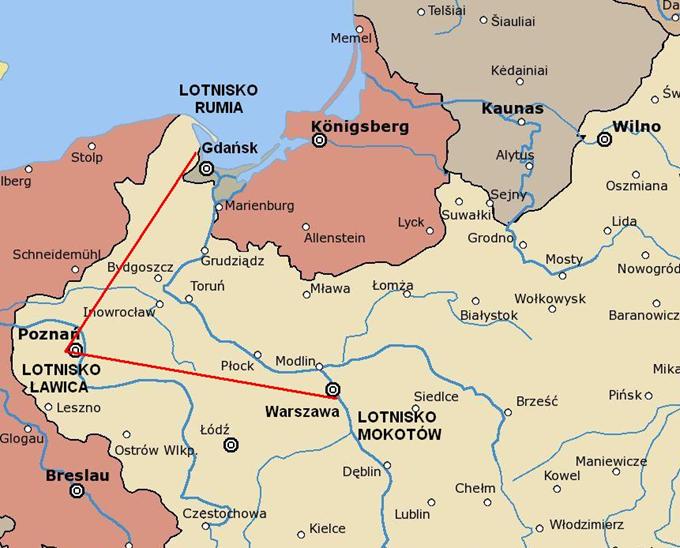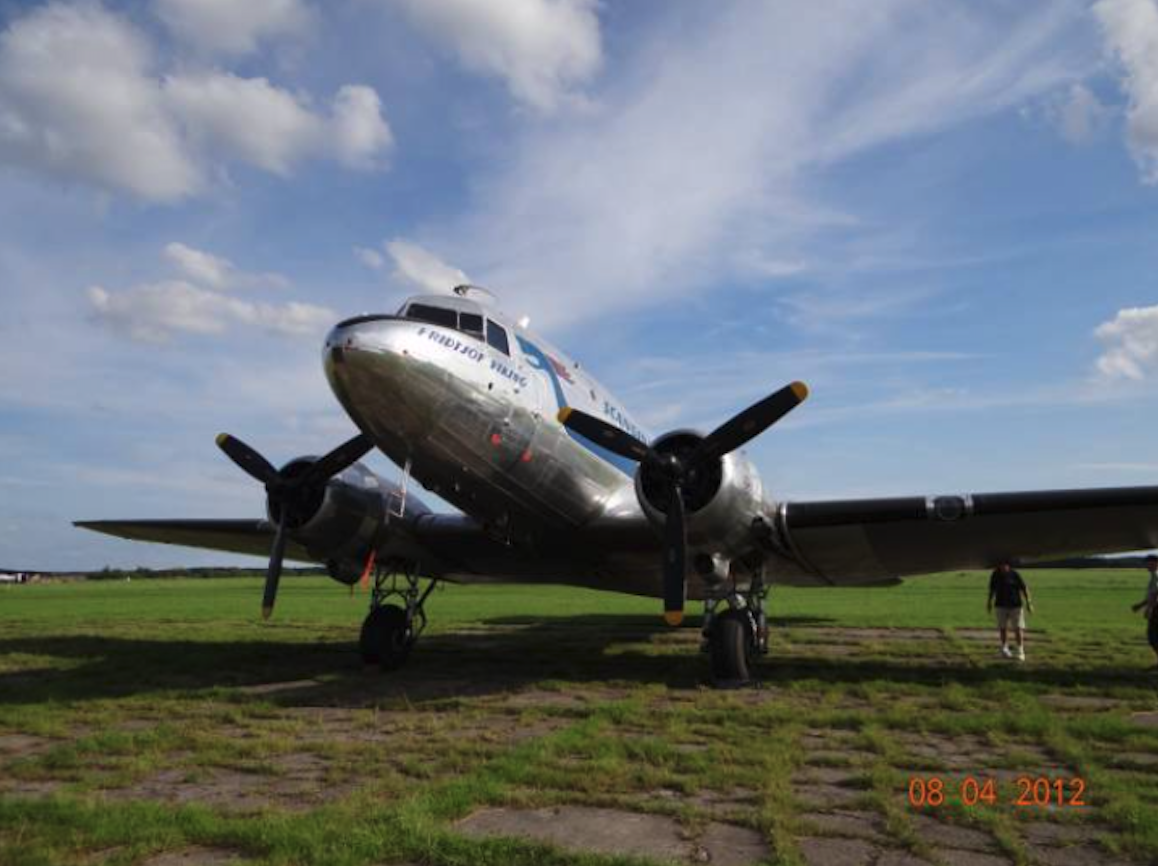Kraków 2014-04-15
Historia Polskich Linii Lotniczych LOT.
Cześć 1
1929r.-1939r.
W dniu 11.11.1918 roku, Rzeczypospolita Polska po 123 latach rozbiorów, odzyskała niepodległość. Pomimo dużych trudności szybko scaliła się państwowo i gospodarczo. Do ojczyzny powrócili lotnicy, którzy brali czynny udział w wielkiej wojnie światowej na wszystkich jej frontach. Ich doświadczenie nie zostało zmarnowane. Najważniejszymi w tym czasie miastami były: Warszawa, Poznań, Kraków, Lwów i Wolne Miasto Gdańsk. Dlatego to te miasta były w miejscu zainteresowania potencjalnych inwestorów komunikacji lotniczej. Już w 1920 roku, pierwsze trasy lotnicze próbowały tworzyć spółki zagraniczne lub z częściowym kapitałem polskim.
Aero-Targ (Aerotarg). 1921 rok.
Pierwsza w Polsce, całkowicie krajowa linia lotnicza, została założona w Poznaniu w 1921 roku. Jej celem była obsługa uczestników i zwiedzających udających się na I Targi Poznańskie. Komitet organizacyjny pierwszych Targów Poznańskich (późniejszych Międzynarodowych Targów Poznańskich) postanowił uruchomić podczas trwania imprezy połączenie lotnicze pomiędzy Poznaniem, Warszawą i Gdańskiem, w celu szybkiego dowozu uczestników targów do Poznania. W tym celu, w dniu 10.05.1921 roku, utworzono Towarzystwo Komunikacji Powietrznej Aero-Targ. W celu sfinansowania przedsięwzięcia komitet organizacyjny targów wyasygnował sumę 5 mln Marek Polskich. Aero-Targ nawiązał współpracę z gdańskim towarzystwem przewozowym Danziger Luftpost, od którego wypożyczył sześć samolotów Junkersów F 13. Linia rozpoczęła działalność 28.05.1921 roku, w dniu otwarciu targów i wykonywała loty do 5.06.1921 roku, do dnia zamknięcia. Z okazji uruchomienia połączenia Poczta Polska wydała okolicznościowy znaczek dopłaty do przesyłki lotniczej. W czasie trwania targów wykonano 58 lotów na trasie Poznań-Warszawa-Poznań i 30 lotów na trasie Poznań-Gdańsk-Poznań, przewieziono około 100 pasażerów i 3 000 kg przesyłek. Jednak przedsięwzięcie okazało się deficytowe i 5 mln Marek Polskich wyłożonych na potrzeby linii nie zwróciło się organizatorom. Mimo to, przedsięwzięcie uznano za sukces.
Polska Linja Lotnicza Aerolloyd. 1922 rok.
Wojna Polsko-moskiewska zahamowała na krótki czas rozwój przewozów komercyjnych. W 1922 roku, powołano do istnienia firmę o nazwie "Polska Linja Lotnicza Aerolloyd". Od dnia 5.09.1922 roku, firma rozpoczęła regularne przeloty na trasie: Gdańsk-Warszawa-Lwów. Po zmianach własnościowych firma stała się spółką z ograniczona odpowiedzialnością "Aerolloyd z o o". W 1925 roku, firma wyemitowała akcje i zmieniła nazwę na "Spółka Akcyjna Aerolot". Jednocześnie przeniesiono siedziba firmy. Firma przeniosła się z Lotniska Gdańsk Wrzeszcz na Lotnisko Mokotów.
Areo Sp z o o. 1925 rok.
W 1925 roku, w Poznaniu powstała firma "Areo Sp z o o", która po pewnym czasie stała się spółka akcyjną i przyjęła nazwę "Aero Komunikacja Powietrzna S.A.". Przedsiębiorstwo korzystało z Lotniska Ławica. Firma ta kupiła samoloty Farman F-70 we Francji. Dwa używane i trzy nowe. Używane maszyny Farman F-70 dotarły do Poznania w dniu 19.05.1925 roku. W dniu 21.05.1925 roku, wykonano pierwsze loty propagandowe nad Miastem. Pierwszy komercyjny lot wykonano w dniu 23.05.1925 roku, na trasie Poznań – Warszawa. Kolejne loty wykonywano także z międzylądowaniem w Łodzi (trasa Poznań-Łódź-Warszawa i z powrotem). Firma przewoziła pasażerów i towary, głównie pocztę. W październiku 1925 roku, z Francji przywieziono 3 nowe samoloty Farman F-70, które były zapakowane w skrzyniach.
W 1928 roku, firma Aero kupiła sześć holenderskich samolotów Fokkerów F.VIIa/1m. Były to pierwsze z prawdziwego zdarzenia samoloty transportowe, o wysokim poziomie bezpieczeństwa i komfortu. To dobre wyniki finansowe pozwoliły na zakup tych nowoczesnych maszyn. Pierwsze trzy samoloty Fokkerów F.VIIa/1m, dostarczono w czerwcu 1928 roku, a kolejne trzy w grudniu 1928 roku.
Do końca 1928 roku, przewieziono około 3 200 pasażerów. W 1928 roku, firma wraz ze sprzętem została przejęta przez PLL LOT, który jednak samolotów Farman F-70 na stan nie przyjął, z uwagi na ich znaczne wyeksploatowanie.
Polskie Linie Lotnicze LOT. 1929 rok.
W tym samym czasie, na terenie USA funkcjonowało już ponad 50 prywatnych linii lotniczych. Aby w Rzeczypospolitej Polskiej nie dopuścić do chaosu i zapewnić jednakowe standardy, w 1928 roku, w Wydziale Lotnictwa Cywilnego w Ministerstwie Komunikacji ruszył program dotyczący zmian w Polskiej Komunikacji Lotniczej. Opracowany i wdrożony program uwzględnił likwidację wszystkich prywatnych firm lotniczych, a w ich miejsce utworzono jedno państwowo-samorządowe przedsiębiorstwo.
Nowa firma przyjęła nazwę "Linji Lotniczych LOT Sp. z o o", a za datę powstania przyjmuje się dzień 29.12.1928 roku, a rozpoczęcie działalności 1.01.1929 roku. W 1929 roku, wspomniane samoloty Fokker zostały przejęte przez nową firmę i były jej podstawą. Pierwszymi używanymi samolotami były Junkers F.13 (15 sztuk) i Fokker F.VIIa/1m (6 sztuk). Samoloty Junkers F.13 służyły w PLL LOT do 1936 roku. Samolotów Fokker F.VIIa/1m w PLL LOT było łącznie 11 sztuk. Samoloty te eksploatowano na liniach krajowych i międzynarodowych, między innymi na szlakach do Wiednia i Czerniowic (przez Lwów i Iwanow-Frankowski).
Po konsolidacji, od dnia 2.01.1929 roku, jako firma "Linji Lotnicze LOT", miały drugą (po Air France), co do wielkości siatkę połączeń. Szybko wychodząc poza obszar Europy, z realnymi planami na loty do Ameryki Południowej i do USA. Wielu Polskich pilotów z PLL LOT przekroczyło w tym czasie 250 000 km, 500 000 km, a także 1 000 000 km przebytych w powietrzu kilometrów.
Od początku istnienia nowej firmy kładziono nacisk na reklamę i wdrażanie nowych połączeń. W Polskich miastach rozklejano liczne plakaty i rozdawano foldery. W Warszawie organizowano loty widokowe. Rozpoczęto loty z Warszawy do Katowic i Bydgoszczy. Na czas Powszechnej Wystawy Krajowej w Poznaniu (znane później jako Targi Poznańskie) uruchomiono specjalne przeloty na trasie Warszawa-Poznań.
W listopadzie 1929 roku, ogłoszono konkurs na znak graficzny dla nowej firmy. Wygrał projekt artysty plastyka z Warszawy pana Tadeusza Groniewskiego, który przedstawia stylizowanego żurawia. W 1931 roku, ten znak graficzny został oficjalnie uznany za godło firmy i jest nim do chwili obecnej (2021 rok). Jest to najstarszy cywilny symbol lotniczy na świecie.
Nazwa przedsiębiorstwa została rozbudowana o przymiotnik ,,Polskie” i pełna nazwa brzmi: "Polskie Linje Lotnicze LOT sp. z o.o.". W 1930 roku, Polskie Linje zostały przyjęte do IATA – Stowarzyszenia Międzynarodowego Transportu Lotniczego.
Pierwszym zagranicznym połączeniem była trasa Warszaw-Bukareszt, Rumunia, realizowane od 1.04.1930 roku, z Lotniska Mokotów. Trasa etapowa Warszawa-Lwów-Czerniowiec-Bukareszt. Kolejne miasta, do których zaczęły docierać samoloty PLL LOT to; Ateny, Bejrut, Helsinki.
1930 rok.
Licencja Fokker F.VII/3m została kupiona w 1928 roku i Polska była jednym z pierwszych krajów, który kupił licencję. Produkcję zlecono firmie Plage i Laśkiewicz w Lublinie. Zbudowano 20 maszyn przeznaczonych dla wojska i 11 maszyn cywilnych. Wersja pasażerska zabierała 10 pasażerów, a transportowa 1 000 – 1 500 kg.. Samoloty te miały silniki rzędowe Lorraine-Dietrich LD-12Eb o mocy 464 KM (341 kW). Od 1935 roku, wymieniono silniki na gwiazdowe Bristol Jupiter VIIF, o mocy 529 KM (382 kW). W Polsce samoloty Fokker F.VII były wykorzystywane jako bombowce, samoloty transportowe i samoloty desantu spadochronowego. Podczas wojny obronnej w 1939 roku, samoloty były wykorzystywane jako transportowe. Przewożono nimi broń i amunicje.
1933 rok.
W 1933 roku, rozpoczęła się budowa nowego centrum PLL LOT umieszczonego na Lotnisku Okęcie. Uroczyste otwarcie nastąpiło w 1934 roku. Do użytku oddano nowoczesny dworzec lotniczy, hangary, magazyny i warsztaty. Przekazano do użytku pomieszczania biurowe, stację meteorologiczną i stację łączności radiowej.
W 1932 roku, prototyp PWS-24 przeszedł próby w służbie PLL LOT, pokonując samolot Lublin R-XVI. W 1933 roku, PLL LOT przyjął na stan samoloty PWS-24. Pierwsze samoloty Polskiej produkcji. Zamówienie złożone zostało na 5 egzemplarzy SP-AJF, SP-AJG, SP-AJH, SP-AJJ, SP-AJK ("Filip", "Gienek", "Hipek", "Jacek" i "Kazik"). Samoloty SP-AGR, SP-AJF i SP-AJJ w połowie 1933 roku, przerobione zostały na aerofoto-metryczne. Samoloty pierwszej serii wycofane zostały z użycia w 1936 roku, z wyjątkiem SP-AJJ wycofanego w 1938 roku.
W 1935 roku, pojawiła się wersja samolotu z mocniejszym silnikiem, która oznaczono PWS-24 bis. Wersja ta zamówiona została przez PLL LOT w kolejnych 5 egzemplarzach; SP-AMN, SP-AMO, SP-AMO, SP- AMR i SP-AMS. Jeden z samolotów z poprzedniej serii, SP-AJH został też przerobiony do wersji PWS-24 bis z nowym oznaczeniem SP-ASY. Dlatego przyjmuje się, że PLL LOT eksploatował 6 samolotów PWS-24 bis.
W 1935 roku, Polska dla PLL LOT zakupiła trzy samoloty Douglas DC-2. Maszyny otrzymały rejestracje; SP-ASJ, SP-ASK, SP-ASL. W dniu 23.11.1937 roku, samolot DC-2 SP-ASJ rozbił się w Bułgarii. Zginęli wszyscy na pokładzie samolotu (6 osób). Po wybuchu II wojny światowej samolot DC-2 SP-ASK internowano w Rydze, a SP-ASL internowano w Rumunii.
1936 rok.
W PLL LOT latał jeden samolot Junkers Ju 52/3m. Wiosną 1936 roku, wytwórnia Junkers przyjęła 9 bardzo zużytych maszyn Junkers F.13 eksploatowanych w PLL LOT, w zamian za jedną maszynę Ju-52/3m. Notabene, firma Junkers musiała zezłomować samoloty F.13, bo nie nadawały się do remontu.
Samolot Ju 52/3m otrzymał rejestrację SP-AKX. Był używany na trasach; Warszawa-Berlin i Warszawa-Saloniki. W dniu 17.09.1939 roku, wylądował w Bukareszcie i został internowany.
Samoloty Lockheed L-10 Electra trafiły na wyposażenie PLL LOT. Z początkiem 1936 roku, dynamicznie rozwijająca się firma PLL LOT nie odstawała poziomem usług i siatką połączeń od innych przodujących przewoźników. Zarząd PLL LOT zdecydował o nabyciu 10 maszyn typu Lockheed L-10 Electra. Z początkiem 1936 roku, do portu w Gdyni przypłynął statek, na którym znajdowały się cztery samoloty. Zostały one zmontowane na Lotnisku Rumia i oblatane. Drogą powietrzną zostały przetransportowane do Warszawy na Lotnisko Okęcie. Otrzymały rejestracje; SP-AYA, SP-AYB, SP-AYC, SP-AYD. Od marca 1936 roku, samoloty rozpoczęły regularne rejsy. W 1937 roku, PLL LOT otrzymał pozostałe 6 maszyn, rejestracje; SP-BGE, SP-BGF, SP-BGG, SP-BGH, SP-BGI, SP-BGJ.
Niestety, samoloty Lockheed L-10 Electra nie latały długo, bo w 1939 roku, armia germańska pozbawiła Rzeczypospolitą Polskę niepodległości, wszczynając II wojnę światową.
1938 rok.
W 1937 roku, zdecydowano się na zakup 10 maszyn nowej, powiększonej wersji, czyli Lockheed L-14. Pierwsze pięć maszyn przypłynęło do Polski na pokładzie transatlantyków MS Batory i MS Piłsudski w kwietniu i maju 1938 roku. Maszyny zmontowano na Lotnisku Rumia, tak samo jak było w przypadku L-10 Electra. Kolejne cztery samoloty przypłynęły do Polski w czerwcu 1938 roku.
Władze spółki PLL LOT postanowiły wykorzystać zakup nowoczesnego samolotu propagandowo. Zdecydowano, że ostatnia z maszyn zostanie sprowadzona z fabryki w Burbank (USA) do Warszawy drogą lotniczą. Miał to być test w ewentualnym uruchomieniu linii lotniczej łączącej Warszawę z New York i Chicago. Co ciekawe, Ocean Atlantycki miał być pokonywany w jego najwęższym miejscu, czyli z Natal w Brazylii do Dakaru w Senegalu. Lot odbył się w maju 1938 roku. Załoga w składzie: Wacław Makowski (dyrektor LOT i pierwszy pilot), Zbigniew Wysiekierski (drugi pilot), Szymon Piskorz (mechanik), Alfons Rzeczewski (radio nawigator) oraz Jerzy Krassowski (asystent) wystartowała fabrycznie nowym samolotem z Burbank w Kalifornii w dniu 13.05.1938 roku. Przez Mazatlan, Meksyk, Gwatemalę, Limę, Buenos Aires i Rio de Janeiro maszyna dotarła do Natalu w Brazylii. Stamtąd w 11 godzin i 10 minut załoga przekroczyła Ocean Atlantyk i wylądowała w Dakarze, pokonując rekordowy dystans 3 070 kilometrów bez międzylądowań. Następnie trasa wiodła przez Senegal, Casablankę, Tunis i Rzym, skąd samolot dotarł w dniu 5.06.1938 roku, bezpośrednio na lotnisko Okęcie w Warszawie. W sumie podczas przelotu z Kalifornii do Polski maszyna spędziła w powietrzu 85 godzin. Przelot na rekordowym dystansie 24 850 km miał znaczenie reklamowe i propagandowe, ale także miał być przygotowaniem do rozpoczęcia w 1940 roku, regularnych lotów transatlantyckich. Plany te pokrzyżował armia niemiecka, wszczynając II wojnę światową.
Wkrótce PLL LOT stracił dwie maszyny: SP-BNG rozbił się w lipcu 1938 roku, koło Campulung w Rumunii, a SP-BNJ spłonął na lotnisku w Bukareszcie niedługo później. By uzupełnić straty, w maju 1939 roku, sprowadzono do Polski kolejne cztery L-14 Super Electra. W czasie wojny obronnej 1939 roku, wszystkie samoloty Lockheed Electra zostały zmobilizowane przez Wojsko Polskie i wykonywały loty kurierskie i zaopatrzeniowe. Następnie cztery z nich ewakuowano do Rumunii, gdzie zostały internowane. Jedna maszyna została internowana w Tallinie w Estonii. Pozostałe trzy samoloty tego typu (SP-BPM, SP-LMK i SP-BNF) ewakuowano do Francji, gdzie służyły, jako samoloty łącznikowe dla Polskiej dyplomacji. SP-BPM został zniszczony podczas ataku niemieckiego na Francję w czerwcu 1940 roku, zaś SP-LMK i SP-BNF odleciały do Wielkiej Brytanii. Tam planowano ich przebudowę na samoloty do zrzutów cichociemnych, jednak ostatecznie wycofano się z pomysłu i obie maszyny przejęły na własność linie lotnicze BOAC.
W 1939 roku, w związku ze zmianami pisowni w Języku Polskim nastąpiła zmiana pisowni firmy z Polskie Linje Lotnicze na Polskie Linie Lotnicze.
W sierpniu 1939 roku, PLL LOT dysponował 26 samolotami komunikacyjnymi.
Niestety. W dniu 1.09.1939 roku, armia germańska dokonała zbrojnej agresji na Rzeczypospolitą Polskę. W wyniku wojny samoloty PLL LOT przebazowano do Rumunii, gdzie 16 maszyn zostało internowanych. Lotnisko Okęcie, zabudowa lotniska, hangary, dworzec, zostały zbombardowane i bardzo zniszczone.
Opracował Karol Placha Hetman



